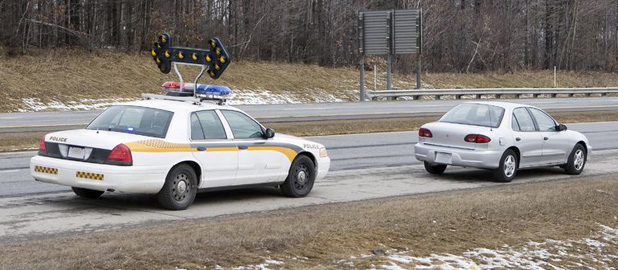Marijuana Case Highlights Charter Rights Test
Routine traffic stop
A man exits a bar and drives away. Police pull him over for a sobriety check.
There’s no odor of alcohol and the driver says he had nothing to drink.
Police check his driver’s licence and vehicle documentation. All in order.
Odor of unburnt marijuana
While standing at the driver’s window, police smell a strong odor of “unburnt marijuana.”
Police caution him “in regards to possession of a controlled substance” and advise him that he does not have to tell police about the marijuana.
Police ask if he has “any marijuana in the vehicle.” The man reaches into the centre console and gives the officer 1.15 grams of marijuana wrapped inside plastic. Police arrest him for possession of marijuana and read him his right to counsel.
At first blush, the case seems simple. But two courts reached different conclusions as to whether the driver should be found guilty.
Police violated driver’s right
At trial in Guelph, Ontario, for possession of marijuana, the man (Mr. Richards) applied to exclude the drug evidence. He argued that because he was detained police should have read him the right to counsel before asking him if he had any marijuana in the car. The judge agreed. In keeping with section 10(b) of the Canadian Charter of Rights and Freedoms, the judge held, police should have told him that he could call a lawyer immediately and that if he did not have one, a free state-funded lawyer was available by calling a toll-free number.
Evidence admitted
Although the trial judge found a breach of the right to counsel, she did not exclude the evidence. As a result, Mr. Richards was convicted and fined $100. He appealed.
The case is an excellent example of how courts apply the test for the exclusion of evidence in a common-place scenario.
Test to exclude evidence
To prove your guilt of a crime, the Crown often seeks to rely on evidence collected by police. Such evidence may consist of contraband (“real” evidence), such as illegal drugs or weapons, or incriminating statements and confessions. If police violate your Charter rights in connection with obtaining that evidence you can apply to have it excluded from your trial. If the judge excludes it, you’ll be acquitted unless the other evidence that the court accepts suffices to prove your guilt beyond a reasonable doubt. In Mr. Richards’ case, without the evidence of the marijuana he’d have been acquitted.
Balance of probabilities
To successfully exclude evidence at a trial, therefore, you must first satisfy the court that one or more of your Charter rights have been violated in connection with the obtaining of the evidence. The standard of proof is on a balance of probabilities, that is, 51 to 49 or, in other words, more likely than not.
If the court is satisfied that one or more of your rights have been breached, it must then consider whether, in the words of Charter section 24(2), admission of the evidence “would bring the administration of justice into disrepute.” The court will exclude the evidence only if it’s persuaded that it would. To determine whether admitting the evidence will have this effect, the court applies a three-part test that was established in 2009 by the Supreme Court of Canada in the case of The Queen v. Grant.
Three-part Grant test
The “Grant” test has three parts:
- First, the court must look at the seriousness of the state conduct that breached your right.
- Second, the court assesses the impact of the violation on your Charter-protected interests.
- Third, the court must consider society’s interest in proceeding with a trial on the merits. Will the truth-seeking function of the trial be better served by the admission of the evidence or its exclusion? In the case of reliable evidence (such as real evidence), this factor favors admission.
In light of its findings in respect to each leg of the test, the court must then determine whether on balance the admission of the evidence would bring the administration of justice into disrepute.
No “pattern of abuse”
The trial judge in Mr. Richards’ case admitted the evidence because she deemed the breach of his right minimal. She found there was no “pattern” of police abuse and suggested that without the illicit questioning, the drugs would have been found anyway.
The appeal court, in a May 2016 ruling, disagreed. Finding that “this was hardly a trivial, technical, or inadvertent breach,” it held “there should have been no legal uncertainty as to the officer’s obligations.” His conduct was “deliberate” and “amounted to a serious violation.”
It noted that the absence of a pattern of abuse was a neutral factor; it did not reduce the seriousness of the violation. Further, the appeal court disagreed that police would have found the marijuana in any event. The court noted that while the officer’s odor-fuelled suspicion justified investigative detention of Mr. Richards and a safety search, it did not warrant a search of his vehicle for drugs.
Breach led to self-incrimination
In respect to the second part of the test, the court found that the violation had a significant impact on his Charter protected interests. The breach led Mr. Richards to incriminate himself and to discovery of the marijuana.
As to society’s interest in having cases tried on their merits, the appeal court observed that this factor was neutral. While the marijuana was reliable evidence, prosecution for possession of 1.15 g, it said, was not an allegation of serious criminality.
Ruling that the court must disassociate itself from the unconstitutional state conduct, the appeal court overturned the conviction and entered an acquittal.










